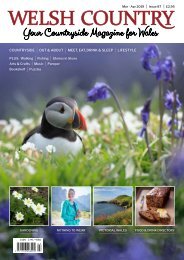Welsh Country - Issue93 - Mar-Apr 20
Create successful ePaper yourself
Turn your PDF publications into a flip-book with our unique Google optimized e-Paper software.
From the
Potting
Shed
“We need more mixed corn”, clucked mother hen, the old
pullet, as she rattled the tin. “That last bag didn’t seem to
last long”.
“Perhaps”, I replied in my usual subtle manner and
looking over her shoulder at her beloved little flock racing
across the orchard at the sound of her, ‘chuck-chuck’
and rattling tin, “perhaps if you stopped feeding the wild
population as well it would last longer”.
“How can you say that?” She responded throwing a welljudged
handful in the direction of the cock pheasant with his
usual harem of four hens. “That cock bird saved our chucks
from disaster”.
Perfectly true, for in the depths of the dismal, grey, soggy
winter we were alerted one morning by the cock pheasant
cackling in alarm on top of the hen house. Despite a gloomy
daylight he had spied a marauding fox sneaking along the
green lane leading from the wood. Although alerting all and
sundry, we were too late for one pullet that he snatched,
but between the brave cock’s alarm calls and our shouts we
saved the remainder.
Although by no means proven, it has been said that the
Romans brought the first pheasants with them. The first
documented evidence is a few years before the Norman
Conquest. The birds are indigenous to Asia from the
Caucasus Mountains in the west to Mongolia and China to
the east. The early residents which became known as Old
English pheasants were from the west of its range and it
wasn’t until the 18th century that the species from further
east with the distinctive white ring-neck appeared. Due
to increase demands from ‘industrial’ sized shoots, game
farmers appear to be breeding more ring-necks but the
smaller, darker birds without the distinctive marking can still
be seen.
Two species of escapees from country house estates
are now recorded as self-supporting wild British birds.
The Golden pheasant is now well established in the East
Anglian brecks and the Lady Amhersts happily nest in the
south-eastern Midlands having escaped from Woburn in
Bedfordshire. But the most stunning, rarely seen outside
captivity or inside a Victorian glass case, is the Reeves
“
Although by no means proven,
it has been said that the Romans
brought the first pheasants with
them. The first documented
evidence is a few years before the
Norman Conquest.
”
pheasant. The cock bird with its pure white head, black eye
stripe, bright chestnut body with black lacing and white wing
feathers again with black lacing sports a six foot barred tail.
“I’ve seen the day”, said Uncle Dick as we leaned on the
gate watching the pheasants quietly feeding in the orchard;
“when I’d ave”, and changed the subject at mother hen’s
scowl.
“Did I ever tell you the night that me and ‘Tickler Tait’
was poaching long tails (pheasants) on Squire Morgan’s
estate?” “Well the best roosts were on the edge of the wood
where the lawn ended; but it was just by the house so we
had to be real quiet”. “Old Tickler had this silent dog called
Sper, short for whisper, he’d bought off a gypsy in the pub
one night; guaranteed never to bark or growl, a real poachers
dog”. “So there we were creeping through the wood; Tickler
with his air rifle looking up for roosting birds and me hangin
on to Sper’s chain”. “When suddenly I sees Tickler raise the
rifle and in an instant there’s such a squawking and this great
bird comes crashing down through the branches, scares
the dog, that bolts and starts howling with its chain rattling
between the trees”. “All the lights come on in the house and
there’s the Squire shoutin about to fetch is gun an all”.
“By damned says I to Tickler, you shot the old boy’s
peacock”.
“What did you do?” I asked
“Followed the dog”, he replied chuckling, “silent enough,
never saw it again”.
Words: Ezra Bay
Illustration: Richard Stockton
52
www.welshcountry.co.uk









